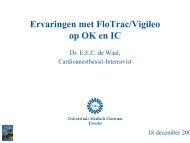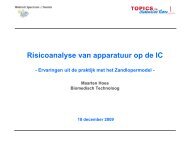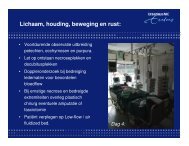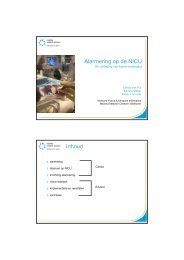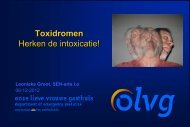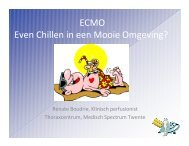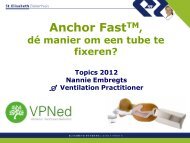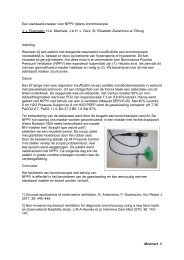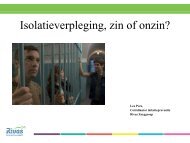(EAdi-signal) and - Topics in Intensive Care
(EAdi-signal) and - Topics in Intensive Care
(EAdi-signal) and - Topics in Intensive Care
Create successful ePaper yourself
Turn your PDF publications into a flip-book with our unique Google optimized e-Paper software.
NAVA (Neurally Adjusted Ventilatory Assist) :<br />
A ventilation tool or a ventilation toy ?<br />
Walter Verbrugghe, MD<br />
Critical <strong>Care</strong> Department<br />
Antwerp University Hospital<br />
walter.verbrugghe@uza.be<br />
08/12/2011
Indication for mechanical ventilation<br />
• ↑ gas exchange<br />
• ↓ respiratory muscle effort
From controlled mechanical ventilation to assisted mechanical ventilaton<br />
Controlled mechanical<br />
ventilation (CMV)<br />
• Volume CMV : IPPV<br />
• Pressure CMV : PCV<br />
Assisted mechanical<br />
ventilation<br />
•SIMV<br />
• ASB/PS<br />
(Proportional) assisted<br />
mechanical ventilation<br />
• PAV<br />
• NAVA
The NAVA (<strong>EAdi</strong>-)catheter<br />
Guide-wire<br />
lumen<br />
Conection to<br />
NAVA module<br />
Feed<strong>in</strong>g lumen
The NAVA (<strong>EAdi</strong>-)catheter
The NAVA (<strong>EAdi</strong>-)catheter
Position<strong>in</strong>g of the <strong>EAdi</strong>-catheter
Position<strong>in</strong>g of the <strong>EAdi</strong>-catheter (cont’d)<br />
At least <strong>in</strong> 2/3 correct position<strong>in</strong>g us<strong>in</strong>g this formula<br />
Barw<strong>in</strong>g J et al. Int <strong>Care</strong> Med, 2009
The <strong>EAdi</strong>-<strong>signal</strong>
Correct position<strong>in</strong>g of the <strong>EAdi</strong>-catheter<br />
p-wave<br />
QRSwave
The ‘normal’ <strong>EAdi</strong>-<strong>signal</strong>
Interference from leak<strong>in</strong>g ECG activity
Interference from IABP
Interference from transvenous pace maker activity
Sett<strong>in</strong>g up the NAVA ventilatory mode<br />
1 st backup<br />
2 nd backup
2. Pressure assist - slope<br />
1. Inspiration - Cycle-on<br />
The mechanical breat<strong>in</strong>g cycle<br />
Inspiration Expiration<br />
4. Expiration - Cycle-off<br />
3. Assist amplitude
<strong>EAdi</strong> <strong>and</strong> ventilator trigger<strong>in</strong>g (cycle-on)<br />
Flow/pressuretrigger<br />
Pressure Support<br />
Ventilation<br />
Assisted breath<br />
<strong>EAdi</strong>-trigger<br />
NAVA
The NAVA-level : slope <strong>and</strong> amplitude + cycle-off<br />
• <strong>EAdi</strong>-<strong>signal</strong> is sampled every 16ms<br />
• The slope <strong>and</strong> the amplitude of the Eadi-<strong>signal</strong> determ<strong>in</strong>es the<br />
slope <strong>and</strong> the amplitude of the mechanical <strong>in</strong>flation<br />
• The NAVA-level serves as an amplifier of the <strong>EAdi</strong>-<strong>signal</strong><br />
Delivered assist (cmH20) =<br />
<strong>in</strong>stantaneous <strong>EAdi</strong> (µV) x NAVA-level (cmH20/µV)<br />
• The mechanical <strong>in</strong>flation is term<strong>in</strong>ated when the <strong>EAdi</strong> reaches<br />
70% of the peak-<strong>EAdi</strong>
<strong>EAdi</strong> as a surrogate of the neural respiratory cycle<br />
Number of active<br />
<strong>in</strong>spiratory neurons ~<br />
Inspiratory effort<br />
Diaphragmatic<br />
Activation ~<br />
Edi (µV)<br />
Mechanical assist ~<br />
tidal volume
Neural<br />
Mechanical<br />
Chemical<br />
The neuro-ventilatory coupl<strong>in</strong>g<br />
Bra<strong>in</strong><br />
Phrenic nerve<br />
Diaphragmatic<br />
contraction<br />
Lung<br />
distention<br />
Alveolar<br />
ventilation<br />
S<strong>in</strong>derby C et al. Cl<strong>in</strong> Chest Med, 2008, 29, 329-342<br />
?<br />
Nerve afferents<br />
Jo<strong>in</strong>t receptors<br />
Baroreceptors<br />
Chemoreceptors<br />
Respiratory<br />
neuron output<br />
Nerve EMG<br />
Diaphragmatic<br />
EMG Edi<br />
Flow Airway trigger<br />
Pressure pressure trigger<br />
PaO Blood<br />
2/PaCO gas<br />
2
NAVA takes advantage of (1) the diaphragmatic activity (<strong>EAdi</strong>-<strong>signal</strong>)<br />
<strong>and</strong> (2) the neuro-ventilatory coupl<strong>in</strong>g mechanism<br />
• The electrical activity generated by the diaphragm is captured<br />
as the <strong>EAdi</strong>-<strong>signal</strong>, serv<strong>in</strong>g as a surrogate for the neural<br />
respiration<br />
• The tim<strong>in</strong>g <strong>and</strong> the <strong>in</strong>tensity of the <strong>EAdi</strong>-<strong>signal</strong> determ<strong>in</strong>es the<br />
tim<strong>in</strong>g <strong>and</strong> the <strong>in</strong>tensity of the mechanical assist delivered by<br />
the ventilator<br />
• The delivered mechanical assist <strong>in</strong> NAVA is not only<br />
synchronous with neural respiration but also proportional to the<br />
ventilatory dem<strong>and</strong><br />
• NAVA establises a ‘connection’ between the neuronal<br />
respiratory centre output (patient) <strong>and</strong> the mechanical assist<br />
delivered by the ventilator on a higher level <strong>in</strong> the neuroventilatory<br />
coupl<strong>in</strong>g (compared to pneumatic triggered<br />
breath<strong>in</strong>g technology)
The mean<strong>in</strong>g of the <strong>EAdi</strong>-<strong>signal</strong><br />
• The Eadi-<strong>signal</strong> = the electrical activity of the diaphragm as<br />
measured at the crux diaphragmatica by a proper positioned<br />
NAVA-catheter<br />
• No ‘normal’ value for <strong>EAdi</strong> <strong>in</strong> a particular patient<br />
• No <strong>in</strong>ter-<strong>in</strong>dividual comparison between patients possible upon<br />
absolute values of <strong>EAdi</strong><br />
• <strong>EAdi</strong>/TV ~ ventilatory efficiency<br />
• High <strong>EAdi</strong>/TV ~ high neuronal output for rather small TV<br />
• Low <strong>EAdi</strong>/TV ~ low neuronal output for rather normal TV<br />
S<strong>in</strong>derby C, Beck J. Neth J Crit <strong>Care</strong>, 2007
Sett<strong>in</strong>g up the NAVA-level
Sett<strong>in</strong>g the NAVA-level = implementation of the neuroventilatory<br />
coupl<strong>in</strong>g pr<strong>in</strong>ciple <strong>in</strong> cl<strong>in</strong>ical practice 1<br />
1 Br<strong>and</strong>er L et al. Chest, 2009;135;695-703
The neuro-ventilatory tool
Sett<strong>in</strong>g up the NAVA-level<br />
• Multiple methods described, optimal method unknown<br />
• Steps : 0,1 µV � 0,2 µV � 0,5 µV ?<br />
• Duration : 4 breaths � 3 m<strong>in</strong>utes ?<br />
• Low � high or high � low ?<br />
• Always (always) set maximum pressure alarm at safe level<br />
to avoid excessive <strong>in</strong>spiratory pressures <strong>in</strong> NAVA<br />
• Probably absolute NAVA-level not so important as long as<br />
situated <strong>in</strong> second response range at least <strong>in</strong> the presence<br />
of <strong>in</strong>tact neuro-ventilatory coupl<strong>in</strong>g<br />
Barw<strong>in</strong>g J et al. Int <strong>Care</strong> Med, 2009<br />
Barw<strong>in</strong>g J et al. Acta Anaesthesiol Sc<strong>and</strong>, 2009<br />
Viale CP et al. Crit <strong>Care</strong> Med, 1998
The neuro-ventilatory coupl<strong>in</strong>g <strong>and</strong> lung-protective ventilation<br />
Terzi N et al. Crit <strong>Care</strong> Med, 2010<br />
Spahija J et al. Crit <strong>Care</strong> Med, 2010
Lung protective ventilation contribut<strong>in</strong>g to the prevention of VILI ?<br />
Br<strong>and</strong>er L. et al. <strong>Intensive</strong> <strong>Care</strong> Med 2009;35(11):1979-1989.
Patient-ventilator asynchrony
Discrepancy between neural respiration <strong>and</strong> mechanical assist<br />
Mechanical respiratory cycle<br />
Neural respiratory cycle<br />
Beck J et al. AJRCCM, 2001<br />
Colombo D et al. Crit <strong>Care</strong> Med, 2008<br />
Aslanian P et al. AJRCCM, 1998<br />
Goulet R et al. Chest, 1997<br />
Tob<strong>in</strong> MJ et al. Crit <strong>Care</strong> Med, 2001<br />
80-550 ms<br />
200 ms
Tim<strong>in</strong>g asynchrony : <strong>in</strong>spiration (cycle-on)<br />
Inspiratory trigger delay<br />
Autotrigger<br />
Wasted effort Double trigger
Tim<strong>in</strong>g asynchrony : expiration (cycle-off)
Assist asynchrony : slope <strong>and</strong> amplitude asynchrony
Determ<strong>in</strong>ants of patient-ventilator asynchrony<br />
• Patient-related factors<br />
• PEEPi <strong>and</strong> dynamic hyper<strong>in</strong>flation 1 (e.g. COPD)<br />
• Shorten<strong>in</strong>g of <strong>in</strong>spiratory muscle <strong>and</strong> flatten<strong>in</strong>g of diaphragm with<br />
horizontal position � compromised diaphragmatic force<br />
• Delayed <strong>in</strong>spiratory trigger<strong>in</strong>g <strong>and</strong> cont<strong>in</strong>ued <strong>in</strong>flation after beg<strong>in</strong>n<strong>in</strong>g<br />
of the neural expiration<br />
• Excessive PS � excessive tidal volume<br />
• Her<strong>in</strong>g-Bruer reflex<br />
• Respiratory alkalosis<br />
� depression of neural <strong>in</strong>spiration<br />
• Sedation level 2<br />
• Technical factors<br />
• Inadequate sett<strong>in</strong>g of the <strong>in</strong>spiratory (pneumatic) trigger<br />
trigger (too sensitive or not sensitive enough)<br />
• Inadequate sett<strong>in</strong>g of the expiratory (flow) trigger<br />
• Air leaks <strong>in</strong> the ventilator circuit (non-<strong>in</strong>vasive ventilation)<br />
1 Ja<strong>in</strong> M et al Critical <strong>Care</strong>, 2007, 11:206<br />
2 De Wit M et al. J Crit <strong>Care</strong>, 2009, 24, 74-80
Asynchrony, pneumatic trigger<strong>in</strong>g <strong>and</strong> PEEPi 1<br />
1 Ja<strong>in</strong> M et al Critical <strong>Care</strong>, 2007, 11:206
Importance of patient-ventilator asynchrony<br />
• Incidence : > 25% of mechanically ventilated patients<br />
• Who : COPD-patients, children,… but many more<br />
• Asynchrony Index (AI) > 10% ~ association with<br />
potential complications 1,2<br />
1. Increased need for sedation <strong>and</strong> muscle relaxants<br />
• ↑ critical illness polyneuropathy or critical illness myopathie<br />
• ↑ ICU‐delirium (� mortality?)<br />
2. Increased ventilatory pressures � risk barotrauma <strong>and</strong> VILI<br />
(Ventilator Induced Lung Injury)<br />
3. Increased duration of mechanical ventilation <strong>and</strong> wean<strong>in</strong>g<br />
� mortality<br />
1 Thille AW et al. <strong>Intensive</strong> <strong>Care</strong> Med.2005, 32, 1515-1522<br />
2 S<strong>in</strong>derby C et al. Neth J Crit <strong>Care</strong> 2007:11(5): 243-252.
Patient-ventilator asynchrony <strong>in</strong> PSV vs NAVA<br />
Spahija J et al. Crit <strong>Care</strong> Med, 2010
Patient-ventilator asynchrony with NIV
<strong>EAdi</strong> as monitor<strong>in</strong>g tool of diaphragm activity <strong>and</strong> prevention of VIDD ?<br />
PSV NAVA<br />
In Yearbook of <strong>in</strong>tensive <strong>Care</strong> <strong>and</strong> Emergency Medic<strong>in</strong>e, 2007. Ed V<strong>in</strong>cent JL
<strong>EAdi</strong> as monitor<strong>in</strong>g tool of diaphragm activity <strong>and</strong> prevention of VIDD ?
<strong>EAdi</strong> as monitor<strong>in</strong>g tool of diaphragm activity <strong>and</strong> prevention of VIDD ?<br />
1 Lev<strong>in</strong>e S et al. NEJM, 2008, 358, 1327-1335
Respiratory muscle weakness is associated with<br />
prolonged mechanical ventilation<br />
De Jonghe B et al. Crit <strong>Care</strong> Med, 2007
The Edi-pattern of VIDD ?
The evolution of the Edi-<strong>signal</strong><br />
Start abdom<strong>in</strong>al breath<strong>in</strong>g excercise
The evolution of the Edi-<strong>signal</strong>
<strong>EAdi</strong> as monitor<strong>in</strong>g tool of diaphragm activity <strong>and</strong> prevention of VIDD ?<br />
• Animal data <strong>and</strong> human data suggests that even short<br />
term diaphragmatic <strong>in</strong>activity is associated with muscle<br />
fiber atrofy 1 .<br />
• VIDD is not uncommon, its prevalence is estimated 25 –<br />
50% <strong>in</strong> mechanically ventilated ICU patients 2<br />
• There is <strong>in</strong>direct evidence VIDD is associated with<br />
wean<strong>in</strong>g failure <strong>in</strong> humans 1<br />
• This may occur even <strong>in</strong> assisted ventilator modes due to<br />
persistent <strong>in</strong>activity of the diaphragm<br />
• Particularly <strong>in</strong> PSV the patient may receive the full assist<br />
only with the use of accessory muscles (even if pneumatic<br />
trigger not too sensitive)<br />
1 Lev<strong>in</strong>e S et al. NEJM, 2008, 358, 1327-1335<br />
2 Decramer M et al. Am J Respir Crit <strong>Care</strong> Med, 2004, 170, 1140-1141
Conclusions
Conclusions : potential benefits of NAVA/Eadi-monitor<strong>in</strong>g ?<br />
NAVA = proportional <strong>and</strong> synchronous assist with preservation of variable breath<strong>in</strong>g<br />
pattern <strong>in</strong>tegrated <strong>in</strong> the neuro-ventilatory coupl<strong>in</strong>g mechanism with direct<br />
visualisation of diaphragmatic muscle activity<br />
Potential benefits :<br />
• Better patient comfort ? Invasive but also non-<strong>in</strong>vasive ventilation (no<br />
<strong>in</strong>terference from air leaks)<br />
• Less need for sedation – muscle relaxants ?<br />
• Less risk for ICU delirium ?<br />
• Better sleep quality ?<br />
• Improved lung protective ventilation ? Prevention VILI ?<br />
• Faster transition from controlled mechanical ventilation to assisted mode ?<br />
• Less duration of mechanical ventilation – faster wean<strong>in</strong>g ?<br />
• Diaphragmatic muscle tra<strong>in</strong><strong>in</strong>g (abdom<strong>in</strong>al breath<strong>in</strong>g excercise ?)<br />
• Prevention of VIDD ?<br />
Delisle S et al. Ann <strong>Intensive</strong> <strong>Care</strong>, 2011<br />
De Jonghe B et al. Crit <strong>Care</strong> Med, 2007
Conclusions : potential <strong>in</strong>dications ?<br />
NAVA<br />
• Non-<strong>in</strong>vasive ventilation<br />
• Much better patient-ventilator synchrony <strong>and</strong> comfort; new st<strong>and</strong>ard ?<br />
• Invasive ventilation<br />
• Patients with major patient-ventilator asynchrony<br />
• COPD<br />
• Children<br />
• The “difficult-to-wean” or “non-weanable” patient ?<br />
• Diaphragmatic disuse/atrophy (prevention is better than cure ?)<br />
• Patient with critical illness polyneuropathy/-myopathy ?<br />
Monitor<strong>in</strong>g the <strong>EAdi</strong>-<strong>signal</strong><br />
• Direct visualisation of diaphragmatic muscle activity<br />
• Prediction of wean<strong>in</strong>g success/failure ?<br />
• Prediction of re-<strong>in</strong>tubation ?
Conclusion<br />
• NAVA is a novel ventilatory mode capable of deliver<strong>in</strong>g a<br />
ventilatory assist synchronous with the neural ventilation on a<br />
breath-to-breath basis<br />
• NAVA has the potential to tra<strong>in</strong> the most important respiratory<br />
muscle, the diaphragm, whereas other (pneumatically<br />
triggered) (assisted) ventilatory modes may actually<br />
consolidate diaphragmatic disuse<br />
• The rationale for NAVA has a sound physiological basis, but<br />
rema<strong>in</strong>s to be proven <strong>in</strong> cl<strong>in</strong>ically trials with relevant cl<strong>in</strong>ical<br />
e<strong>in</strong>dpo<strong>in</strong>ts<br />
• The adoption of NAVA as a new ventilatory mode will require a<br />
drastical lower<strong>in</strong>g of the cost of the NAVA-catheter<br />
• If NAVA as a ventilatory mode is not applicable; the monitor<strong>in</strong>g<br />
of the Eadi-<strong>signal</strong> alone may provide important <strong>in</strong>formation to<br />
the cl<strong>in</strong>ician <strong>and</strong> needs further research
hank you



